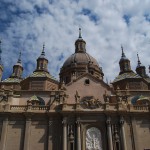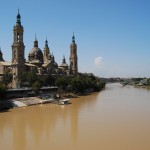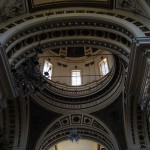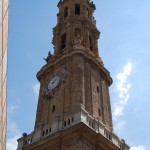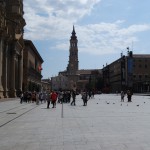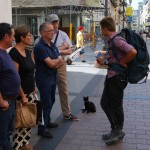Cathedral of Our Lady of the Pillar and La Seo Cathedral in Zaragoza
The main Christian sanctuary of Zaragoza is the Cathedral of Our Lady of the Pillar. The Cathedral’s dimensions are striking: it is 130 meters long, and 67 meters wide; it has 11 domes, 4 towers each 90 meters tall, and 9 inner chapels.
The first Christian church appeared on this site back in the 1st century A.D. According to an old tradition, Saint Apostle James (James son of Zebedee, the elder brother of Apostle John), one of the Twelve Apostles of Jesus Christ, preached in this area around 40 A.D. The local pagan people did not receive the Good News and did not accept the Christian teaching, so Apostle James became disheartened. According to the legend, on January 2, 40 A.D., a miracle happened. Together with his disciples James prayed on the banks of the EbroRiver, when Virgin Mary appeared before him in a miraculous way, standing on a pillar (Spanish pilar) in the company of angels. She gave to the Apostle a jasper pillar and a small wooden statue of herself. She also charged him to build a chapel in her honour on this site, “This place is to be my house and this image and column shall be the title and altar of the temple that you shall build.”
The first chapel dedicated to Our Lady, just like many other Christian sanctuaries, was destroyed at the time of persecutions against the Christians. But Zaragoza’s citizens were able to save the statue of the Holy Virgin and the column. Under the rule of the first Christian Emperor Constantine the Great, between 306 and 337, on the site of the first chapel a basilica was built that was later rebuilt in the Romanesque style.
There is a belief, according to which the revered relic that was kept in Zaragoza, forced King Alfonso I to start the Reconquest and free Zaragoza from the Moors in 1118. It was the most significant victory of the King of Aragon.
The Romanesque church was damaged by fire in 1434, and only the tympanum of the southern façade has survived till our days. Soon, there was a temple here in the Gothic Mudéjar style. Of that construction the alabaster altarpiece by Spanish architect and sculptor Damian Forment (1480-1540), which he made in 1509-1512, and the choir stand remain intact.
The construction of the current cathedral in Baroque style started in 1681-1686, during the reign of Spanish king Charles II (1661-1700). In 1725, the Cabildo (city council) of Zaragoza made a decision to revamp the temple. Later, architect Ventura Rodriguez (1717-1785) was commissioned to carry out the project; and he created the volume that is present there today.
Marble, bronze and jasper were used in the cathedral’s decoration. The vaults and domes were painted by Francisco Goya (1746-1828), native of Fuendetodos, near Zaragoza. On the square next to the cathedral there is a monument dedicated to Francisco Goya. The reconstruction of the basilica was finished only in 1872. During the civil war in Spain (1936-1939), three bombs were dropped on the Cathedral of Our Lady of the Pillar, but none of them exploded. Two of those bombs are still on display at the cathedral.
The main relic of the Cathedral of Our Lady of the Pillar is kept in the eastern section of the cathedral. In 1754, Ventura Rodriguez made a Holy Chapel here – a temple within the temple. The statue of the Holy Virgin of the Pillar is only 39 centimeters high; it is made out of wood. It stands on a jasper column. In 1905, a crown was placed on the statue’s head which at that time was worth 450 thousand pesetas.
Every year on October 12, the holiday of Our Lady of the Pillar is celebrated to commemorate the first apparition of the mother of God to the Spanish. By coincidence, on 12 October 1492, Christopher Columbus discovered America. This is why Our Lady of the Pillar is revered as the patron of all Hispanics. Every country of Latin America donated to the statue their national costumes.
Not far from the Cathedral of Our Lady of the Pillar there is another unique monument of Zaragoza’s architecture – it is La Seo Cathedral. The full name of La Seo Cathedral is the Cathedral of the Saviour’s Baptism in Zaragoza, or Cathedral of the Saviour (Catedral del Salvador) in short. The name La Seo comes from the name of the square – Plaza de la Seo, on which it is located. Its history perhaps could provide a plot for a thrilling movie – so many twists and turns it contains.
During the period of Antiquity, there was a forum on this site. The Forum was a civil and commercial center of the city; the main temple was also located here. At the present time, under Plaza de la Seo there is a museum of the Forum.
In the 8th century, Hanas ben Abdallah as San’ani – a descendant of one of the disciples of prophet Mohammed, ordered to build on the site of the forum the main mosque of Saraqusta al Baida, as the city was called at that time. This mosque is believed to be one of the oldest mosques in Muslim Spain. The construction was expanded twice – in the 9th and 11th centuries. The entrance to the mosque was located in the same place, where the entrance to the cathedral was made later. During the restoration works completed in 1998, several details of that mosque were uncovered – a fragment of the minaret on the external wall, and the ancient floor.
After Zaragoza was liberated in 1118 by Alfonso I, the Battler (1073-1134), the local Muslim population had to leave the city within one year. The mosque was closed and renovated. On October 4, 1121, the former building of the mosque was consecrated in the name of the Holy Saviour (San Salvador).
In 1140, the old church made from the mosque was torn down almost to the ground, and in its place the construction of a new cathedral in Late Romanesque style was started. The new edifice was made out of stone in the shape of a basilica. According to the testimony of the archival records, beside it there was a refectory, maternity hospital, and two monasteries. Two apses, and a number of sculptures in the chancel have survived to our days.
From 1204 until the beginning of the 15th century, all kings of Aragon were crowned in La Seo, according to a special privilege, granted by Pope Innocent III. It was a solemn ceremony. The king would spend the night before the coronation keeping watch in the AljaferíaPalace. Then the procession walked to the Cathedral of the Saviour, where a pompous ceremony took place, consisting of four stages: the investiture of arms; unction with holy oil; placing of the crown and handing the royal insignia; and oath of the fueros (statutes) and liberties of the Kingdom of Aragon. After the 15th century, the kings only swore to the fueros of Aragon. Royal baptisms, weddings, and burials were also performed in the cathedral.
In 1318, the Archbishopric of Zaragoza was created, and La Seo became the metropolitan cathedral. In 1346, in order to provide light for the chancel, a Mudèjar dome was started. The works were finished in 1376. In 1360, the main façade was rebuilt in the Mudèjar style and the so-called Parroquieta was added – the church of Archangel Michael (San Miguel), which is a funeral chapel of the Archbishop of Zaragoza in 1317-1345, Pedro López de Luna. Aragonese and Seville masters participated in the creation of this elegant construction in the Mudèjar style.
In 1403, the old dome collapsed, and by the order of Antipope Benedict XIII (Pedro Martinez de Luna, 1328-1423, who had been elected Antipope in 1394), who was Aragonese by birth, the reconstruction of the Saviour’s Cathedral began. The new dome resembled the shape of the Papal Tiara. During the 16th and 17th centuries, La Seo was one of the centers of the Aragonese school of polyphonic music.
17th century is marked with another interesting event. In the background of it was the fact that between La Seo and El Pilar Cathedrals there was an old rivalry over the Cathedral status in the metropolitan. In the 17th century, the cathedral chapter of El Pilar even filed a suit to win the episcopal seat. But the claim was dismissed by Spanish King Philip IV, who gave the seat to La Seo’s dean. The disputes would not be resolved until 1676, when Pope Clement X (1590-1676, elected Pope in 1670) made the Solomon-like decision: six prebendaries and 15 canons would reside in La Seo, and the same in El Pilar, and the dean would live six months in each one. Since that time in Zaragoza there are two cathedrals (with co-cathedral statuses) – the Cathedral of the Saviour, and the Cathedral of Our Lady of the Pillar.

